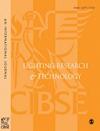DeepLux:一种数据驱动的3D照度图估计方法和基准
IF 2.2
3区 工程技术
Q2 CONSTRUCTION & BUILDING TECHNOLOGY
引用次数: 0
摘要
在本文中,我们提出了一个管道和基准,称为DeepLux,用于预测三维点云的照度。计算光度精确照明的经典算法是基于数值和解析模型的,这些模型通常计算成本很高,特别是在具有复杂几何形状的情况下。与现有方法不同,我们的算法是第一个基于学习的方法,能够预测准确的照度地图信息,可用于实时智能照明应用。我们还对两个互补的任务进行了评估,即光位置和强度估计,这是照明设计领域的重要方面。此外,我们提供了一个广泛的新颖的光度正确数据集,我们使用它来训练和评估我们的方法。实验表明,所提出的算法产生的结果与最先进的算法相当,甚至更好(实际测试中的平均误差+8%),同时实现的模拟时间比其分析对手更快,特别是在复杂的合成和现实世界场景中。本文章由计算机程序翻译,如有差异,请以英文原文为准。
DeepLux: A data-driven method and benchmark for 3D illuminance maps estimation
In this paper, we propose a pipeline and benchmark, called DeepLux, for predicting illuminance on 3D point clouds. Classic algorithms for computing photometrically accurate illumination are based on numerical and analytical models which are generally computationally expensive, especially in scenarios with complex geometries. Unlike existing approaches, our algorithm is the first learning-based method that is able to predict accurate illuminance map information that could be used for real-time smart lighting applications. We also evaluate our approach on two complementary tasks, that is, light position and intensity estimation, which are important aspects in the field of lighting design. Additionally, we provide an extensive novel photometrically correct dataset, which we use for training and evaluating our approach. Experiments show that the proposed algorithm produces results on par with or even better than the state of the art (+8% average error in real tests) while achieving faster simulation timings than its analytical counterpart, especially in complex synthetic and real-world scenarios.
求助全文
通过发布文献求助,成功后即可免费获取论文全文。
去求助
来源期刊

Lighting Research & Technology
工程技术-光学
CiteScore
5.40
自引率
16.00%
发文量
69
审稿时长
>12 weeks
期刊介绍:
Lighting Research & Technology (LR&T) publishes original peer-reviewed research on all aspects of light and lighting and is published in association with The Society of Light and Lighting. LR&T covers the human response to light, the science of light generation, light control and measurement plus lighting design for both interior and exterior environments, as well as daylighting, energy efficiency and sustainability
 求助内容:
求助内容: 应助结果提醒方式:
应助结果提醒方式:


